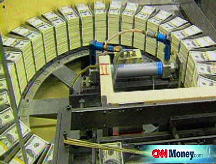Good news when this bubble pops
A flight to safety has created a rush into Treasurys. But experts say when this bubble bursts, it will be a sign of an improving economy.

NEW YORK (CNNMoney.com) -- The next bubble is here...but this is one many people want to see popped.
Investors are snapping up Treasurys as they seek a safe haven from the market turmoil whipsawing the world. So afraid of anything risky, investors are even willing to give up interest payments to make sure their principal is safe.
Four-week Treasurys offer no yield, while the rates on some longer-term U.S. securities are at their lowest level in decades.
Treasurys are viewed as one of the world's safest investments because they are backed by the U.S. government. Investors, from foreign governments to gray-haired ladies, are stocking up so they can sleep better at night.
This flight to safety has pushed Treasurys to their highest prices and best returns in years. Bond prices move in the opposite direction from yields.
The three-month Treasury bill has returned 1.42% over the past 90 days and 4.01% over the past year, assuming interest is reinvested, as of Dec. 18.
The 10-year Treasury note has returned 11.29% over the past 90 days and 20.4% over the past year, while the 30-year bond has returned 23% over the past three months and 34% over the past year - their best returns since the 1982 recession.
Bubbles usually inspire frenzy and fear. Be it the 17th century tulip bubble, the dot-com bubble of the 1990s or, most recently, the real estate bubble, these manias don't end well. The current so-called Treasury bubble, however, is different.
Most bubbles form because investors feel there's lots of money to be made. As new people pile in to a particular asset, the price soars, further fueling the frenzy. When the craze finally ends, the price usually plummets.
Treasurys, however, have soared in popularity recently because people are afraid of other markets. Few investors feel they can make money in Treasurys. They are mainly just trying not to lose money.
"We're seeing more that there is a lot of fear," said Sheryl King, senior U.S. economist at Merrill Lynch, who added that investors are flocking to Treasurys because the market is the most liquid in the world.
When the Treasury bubble does pop, it will likely be a sign that the economy is turning around and that credit is more available again, experts said. People will sell off their Treasury holdings because they think that stocks and corporate bonds will offer better returns.
Ward McCarthy, managing director of Stone & McCarthy Research Associates, thinks a potential sell-off in Treasurys would not "be indicative of trouble in Treasurys, but more an indication of better investment opportunities in other markets."
"We all hope that happens," he said.
Meanwhile, there are benefits to record low interest rates for Treasurys. It means that the U.S. government can borrow money at very low cost, which it will need to do next year since it is likely to spend heavily on infrastructure as part of a new economic stimulus package.
The popping of the Treasury bubble will not be pain free, however.
While investors are favoring shorter-term securities, some searching for more yield are piling into Treasurys with longer maturities. The yield on the benchmark 10-year note hit an all-time low of 2.07% Thursday.
But investors could lose money even on super-safe Treasurys. A swift increase in yields would send prices plummeting. For every 1 percentage point increase in yield on a 10-year note, investors would see a corresponding 7 percentage point drop in value, said Eric Jacobson, senior bond fund analyst at Morningstar.
It could happen. A year ago, the yield on a 10-year note was more than twice what it is now and 18 months ago, it was 5.26%
This would leave investors in a tough bind - either hold onto a note with yields that could be far lower than the market rates at the time or sell it at a steep loss.
Also, if rates rise next year, President-elect Barack Obama could find it more difficult to fund his stimulus package, which some say could reach $1 trillion.
"The interest tab on that borrowing could grow," said Jane D'Arista, director of programs at the Financial Markets Center. "It might limit the price tag of what Obama could do." ![]()






